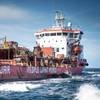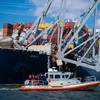According to the Quarterly Incidents Briefs summary for cases closed in the New York area during the first quarter of calendar year 1999, nearly 60 percent of the incidents involving vessel casualty or malfunction were related to equipment failure - either by normal wear and tear, or through lack of preventive maintenance.
Also included in the report are incidents which occurred on vessels at sea, enroute to New York City at the time of the incident.
Of the 49 cases, lack of preventative maintenance was the cause of 16 incidents, the highest total of the five causes, which also include mechanical error, human error, shoaling and miscellaneous.
In many cases, the incidents described are not disastrous, for example; falling under the category of lack of preventive maintenance are two incidents:
In one, occurring July 2, 1998, a foreign passenger vessel lost propulsion and power for five hours, principally due to a diesel generator malfunction. In another instance, occuring September 1, 1998, a small U.S. passenger vessel departed with passengers aboard and lose control air pressure. It managed to maneuver back to the dock and discharge passengers using the last of its stored air. The electric motor used to drive the air compressor had failed, due to worn brushes.
The second most common cause of incidents, was equipment malfunction through normal wear and tear. Notable occurrences include one on December 31, 1998, in which a foreign tank ship lost all propulsion. It had previously been aground, however, after being refloated, the main engine starting air system was clogged with debris and could not provide enough starting air to the main engines. Another incident took place on October 15, 1998, in which a vessel experienced an equipment failure affecting its fitness for service. While getting underway, the vessel lost power from the starboard engine, which forced personnel to secure the engine to isolate and assess the problem. In that case, a faulty gasket head was the cause, due to stresses induced by normal vessel service.
Human error, with 10 instances, was the third most common cause for incidents. In these cases, there were any number of end results, ranging from a U.S. passenger vessel alliding with a docked U.S. passenger vessel, resulting in extensive cosmetic damage to its port mid-section, second deck; to an incident occurring on August 5, 1998, in which a dredge unintentionally grounded while maneuvering in shallow water with a defective port dredge pipe. It accidentally ran over the attached dredge pipe, causing damage to the bilge plate and three trip frames in the #3 port void spaces. That incident was ruled caused by the operator's lack of awareness.
Possibly the worst instance occurred on August 23, 1998, in which a small passenger vessel capsized, sending all persons on board into the water. One passenger became trapped under the capsized vessel and drowned. The apparent cause was the grossly negligent actions of the owner and master to operate the vessel in violation of numerous shipping regulations, which decreased passenger safety. The root cause was determined the vessel had nominal stability and was overloaded for the voyage.
Shoaling was a contributing factor in four incidents, and miscellaneous factors were the cause of five. The miscellaneous causes included the following reasons:
· Facility berth lacking navigable channel from Hudson River.
· Failure/inadequate use of tagline to lower mooring line.
· Lack of specific UKC guidance for barge loading ops at berth.
· Lack of vessel tug assist while docking.
· Inattentive maneuvering by tug mate.
Sponsored Content
Chris-Marine’s solutions help to prolong engine lifetime

AST is now AST Networks, bringing you remote connectivity wherever you are

March 2024
 Read the Magazine
Read the Magazine

 Read the Magazine
Read the Magazine
This issue sponsored by:

America’s Watershed Initiative: Sustaining a Critical Waterway
March 2024
 Read the Magazine
Read the Magazine

 Read the Magazine
Read the Magazine
This issue sponsored by:

Preparing for Change, ABS Enhances the Marine Vessels Rules Book
Subscribe for
Maritime Reporter E-News
Maritime Reporter E-News is the maritime industry's largest circulation and most authoritative ENews Service, delivered to your Email five times per week










